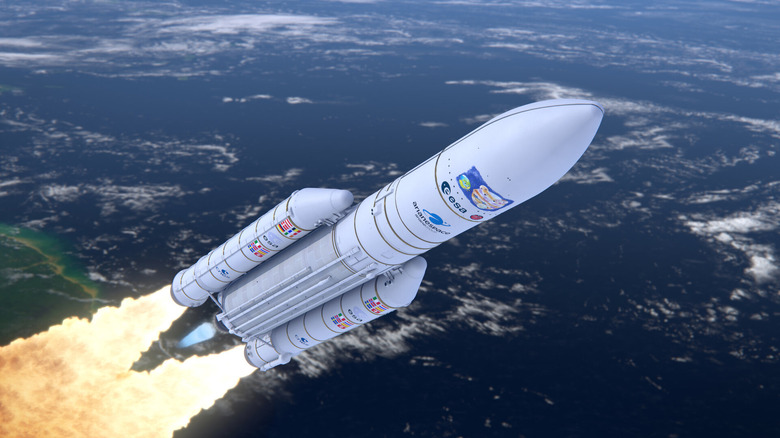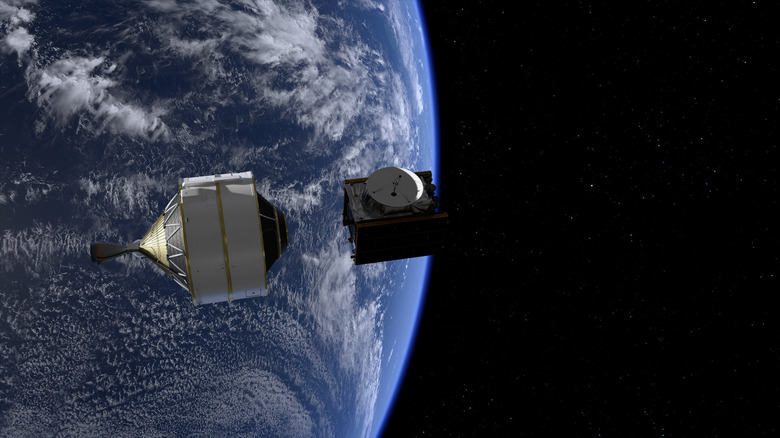How To Watch The JUICE Spacecraft Launch To Jupiter's Icy Moons This Week
This week will see an exciting spacecraft launch, as the European Space Agency (ESA) launches its JUICE craft to visit the icy moons of Jupiter. The Jupiter Icy Moons Explorer mission will launch from Europe's Spaceport in French Guiana using an Ariane 5 rocket. The launch will be livestreamed so you can watch along at home.
The launch is scheduled for Thursday, April 13. Coverage begins at 1:45 p.m. CEST for those in Europe, which is 7:45 a.m. EST or 4:45 a.m. PT for those in America. There will be information about the mission, including interviews with experts and those who worked on the spacecraft. The launch will be at 2:15 p.m. CEST (8:15 a.m. EST or 5:15 a.m. PT).
Other milestones to look out for are the separation of the JUICE spacecraft from the Ariane 5 upper stage at 2:42 p.m. CEST, the acquisition of the first signal from the JUICE spacecraft, which should be some time after 2:51 p.m. CEST, and the completion of the deployment of JUICE's solar arrays which should be at 3:55 p.m. CEST.
Once the launch is completed and the spacecraft has separated from the rocket and deployed its solar arrays, there will also be a post-launch briefing scheduled for 4:30 p.m. CEST with more information about how the launch went and what is next for the JUICE spacecraft.
To watch the JUICE launch livestream, you can either head directly to ESA's Web TV site or ESA's YouTube channel.
Why the JUICE spacecraft is heading to the Jupiter system
JUICE will be traveling to the Jupiter system to investigate the icy moons around the planet. It will visit three of Jupiter's largest moons, Ganymede, Callisto, and Europa, believed to have liquid water oceans beneath thick icy crusts.
Scientists know that the presence of liquid water is essential for an environment to be habitable, so the possibility that it exists on distant moons is fascinating. The moons are very far from the sun and, therefore, icy, so liquid water can't exist on their surfaces. But previous missions like NASA's Voyager 1 spacecraft, which passed Jupiter in the 1970s, found indications that an ocean could be beneath the ice of Europa.
Subsequent missions like NASA's Galileo spacecraft found evidence that plumes of water could be bursting to the surface of Europa, supporting the idea of an ocean beneath the icy crust. The Hubble Space Telescope found more evidence of such plumes, making it seem increasingly likely that liquid water is on these bodies.
Some of Jupiter's other moons also have evidence of liquid water oceans, like Hubble's data suggesting water vapor on the moon Ganymede. Scientists have looked at the magnetic fields of Europa and Callisto and found that these fields also indicate the presence of oceans beneath the surface.
JUICE's journey to the Jupiter system
JUICE aims to investigate three of Jupiter's moons in more detail and to confirm whether there are, in fact, liquid water oceans there. It will also look into the complex magnetic fields of the Jupiter system, as the planet Jupiter's magnetic field could be interacting somehow with the moon Ganymede to create Ganymede's unusual magnetic field.
But the big aim is to learn about the habitability of these moons. JUICE has ten instruments on board, including spectrographs, a camera to snap images of the moons, and technical instruments for measuring gravity and magnetic fields.
Once launched, JUICE will travel for eight years before arriving at the Jupiter system in 2031. The path it will take includes flybys of several planets to give it a boost on its long journey, including several flybys of Earth and one of Venus. It will also attempt the first-ever flyby maneuver using Earth's and the moon's gravity, called a Lunar-Earth gravity assist.
You can track the JUICE spacecraft's progress to the Jupiter system via the Where is Juice now? website. That will show details of the craft's current location and the planned maneuvers, like the various planetary flybys and the journey through the solar system.

